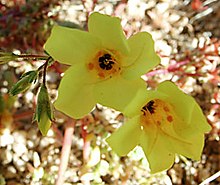Leptosiphon aureus
| Leptosiphon aureus | |
|---|---|

| |
| Scientific classification | |
| Kingdom: | Plantae |
| Clade: | Tracheophytes |
| Clade: | Angiosperms |
| Clade: | Eudicots |
| Clade: | Asterids |
| Order: | Ericales |
| Family: | Polemoniaceae |
| Genus: | Leptosiphon |
| Species: | L. aureus
|
| Binomial name | |
| Leptosiphon aureus (Nutt.) J.M.Porter & L.A.Johnson
| |
| Synonyms | |
|
Leptosiphon aureus var. aureus − (Nutt.) E. Vilm [1] | |
Leptosiphon aureus is a species of flowering plant in the phlox family known by the common name golden linanthus.[2]
It has been reclassified by the USDA and the Jepson Manual (TJM2) from a binomial nomenclature to two subspecies: Leptosiphon aureus var. aureus for the majority of populations,[1][3] and Leptosiphon aureus subsp. decorus for a smaller range of populations.[4][5]
Distribution
The plant is native to the Southwestern United States in Arizona, Nevada, New Mexico, and Southern California; and to northwestern Mexico in Baja California state.[6]
It grows in desert flats and desert chaparral of the Mojave Desert and Sonoran Desert; in chaparral and woodlands of the Peninsular Ranges and Transverse Ranges; and in pinyon-juniper woodlands and madrean pine-oak woodlands of Madrean Sky Islands.[2]
Description
Leptosiphon aureus is an annual herb producing a thin, threadlike stem with occasional leaves divided into narrow needlelike lobes. The oppositely arranged leaves are each divided into very narrow bristlelike lobes up to a centimeter long.[7]
The tip of the stem has an inflorescence of usually a single flower with corolla lobes under a centimeter long. With the two subspecies: ssp. aureus generally has bright to golden yellow flowers; while ssp. decorus has white or cream blooms. The bloom period is March to June.
Subspecies
Two subspecies, currently replacing the binomial species name in taxonomy, overlap in geography but do not occur together.[8][2]
- Leptosiphon aureus ssp. aureus — pinyon-juniper woodlands, madrean pine-oak woodlands in Madrean Sky Islands, and desert flats.[3][1]
- Leptosiphon aureus subsp. decorus — endemic to Mojave Desert in California.[5][4]
References
- ^ a b c GRIN-Global Web v 1.9.4.2: Taxonomy of Leptosiphon aureus var. aureus, (Nutt.) E. Vilm/Elisa de Vilmorin . accessed 2.28.2016.
- ^ a b c Calflora: Leptosiphon aureus
- ^ a b Jepson eFlora: Leptosiphon aureus ssp. aureus[permanent dead link]
- ^ a b GRIN-Global Web v 1.9.4.2: Taxonomy of Leptosiphon aureus var. decorus
- ^ a b Jepson: Leptosiphon aureus subsp. decorus[permanent dead link]
- ^ GRIN-Global Web v 1.9.4.2: Taxonomy of Leptosiphon aureus var. aureus
- ^ Jepson: Leptosiphon aureus
- ^ Jepson eFlora: Leptosiphon aureus[permanent dead link]
External links
- Leptosiphon
- Flora of the Southwestern United States
- Flora of California
- Flora of Baja California
- Flora of New Mexico
- Flora of the California desert regions
- Flora of the Sonoran Deserts
- Natural history of the California chaparral and woodlands
- Natural history of the Colorado Desert
- Natural history of the Mojave Desert
- Natural history of the Peninsular Ranges
- Natural history of the Transverse Ranges
